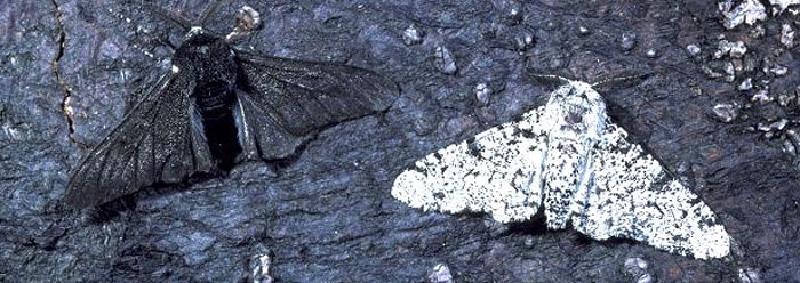Part 2: Primer on a resource on the peppered moth and evolution, using digitized specimens from the collections of the Natural History Museum.
The story of the peppered moth is a great illustration of evolution by natural selection. And the study of the phenomenon now called industrial melanism is also a great example of how science operates.
Peppered moth PowerPoint - free to download!
Evolution
The peppered moth (Biston betularia) is a species with huge variation. They can be white and speckled (which is the typica colour form ) to almost entirely black __ (the carbonaria form ). In the 19th century, collectors in Britain noticed that the darker form was becoming more common.
At this time coal had been fuelling the industrial revolution. This put out huge amounts of air pollution, including lots of sulphur compounds. When these mixed with water vapour in the atmosphere it formed sulfuric acid, which fell as acid rain. This is not great for plants, particularly lichen, some species are very sensitive to this. The death of these light-coloured lichens and soot from the coal, led to darker tree trunks and branches in forests around big industrial cities such as Birmingham and Manchester.
Naturalists guessed that darker carbonaria moths were better camouflaged against the darkened trees, and less likely to be eaten by birds. Burning coal was changing the environment and putting selective pressure on peppered moths making it more likely for darker forms to survive. The carbonaria form became uncommon in peppered moth populations, and the phenomenon became known as industrial melanism. Since the Clean Air Act came into force in the UK in 1956, lichens have regrown and the lighter coloured moths have become more common again. And the peppered moth has become a textbook example of evolution by natural selection.
Science at work
The story of naturalists investigating this phenomenon is also a good window into how science operates. In the 1950’s scientists experimented by putting moths on trees and seeing if colour and contrast with tree trunks had an effect on a bird’s likelihood of finding and eating the moth. Part of the old maxim is to never work with animals, I imagine because you can’t tell them what to do. So often these scientists worked with dead moths, pinning or gluing them to tree trunks, and finding that moths camouflage against the trees was at work.
However these methods came under heavy criticism, and for a while peppered moths were knocked off their textbook pedestal. The main criticisms centered around scientists creating experimental situations which did not accurately reflect the real world. Dead moths can’t sense birds and fly away. And scientists had been pinning them to tree trunks (probably because it was convenient), when it was argued that peppered moths tended to hide on tree branches.
Scientists responded to this criticism by designing experiments differently. The most comprehensive was conducted by Michael Majerus. Majerus examined trees and noted the resting positions of wild moths. Then using this information he released thousands of live moths over several years at densities reflecting a wild population. He kept them in ‘sleeves’ around resting locations until they settled at sunrise. Then he removed the sleeves and would return 4 hours later. The moths rarely flew away, so missing moths were presumed eaten. He also observed some of the moths through binoculars and recorded what they were eaten by, and found it was indeed birds doing the eating.
Read more about Majerus’ research - Royal Society: Biology Letters
Activity ideas
Tracking industrial melanism
Discuss images of moth samples collected across several decades. Is the mix of colour forms the same in each one? Why might the increase and then decrease in burning coal have an impact on the colour of the moth population? Could you conduct and experiment to collect evidence to support your hypothesis?
Model moths
Make model moths with clay or dough and paint them light or dark patterns. Bring your moths outside and see what natural surfaces your moths can camouflage on. What would happen to your moth if the environment changed due to deforestation? What if one type of tree or plant in your environment died out and other became more common? What if there were no natural surfaces, only human made ones?
Moths in unnatural habitats
Think about the habitat of your classroom or home. Research UK moths. Which UK moths might be camouflaged in your classroom or home? Is camouflage enough for a moth to survive and reproduce? You could also draw and colour in your own new moth species which would be suited to your surroundings.
Gather your own evidence
Design an experiment to test the story of the peppered moth. How could you collect evidence that the colour of a moth and the colour of tree bark affects chances of surviving and reproducing?
